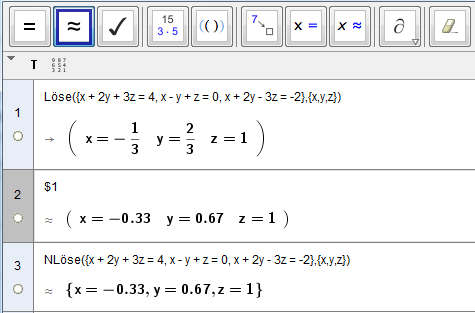Inhaltsverzeichnis
zu  6, S. 23 - 42, S. 106 - 107 6, S. 23 - 42, S. 106 - 107 | Technolgie-Tipps zu Gleichungssystemen |
Lineare Gleichungssysteme mit 3 Unbekannten
Lineare Gleichungssysteme mit zwei Variablen kannst du grafisch mit GeoGebra lösen. Für lineare Gleichungssysteme mit 3 und mehr Unbekannten verwendest du ein Computer-Algebra-System, z.B. GeoGebra CAS.
„Per Hand“ löst du lineare Gleichungssysteme mit 3 Unbekannten am besten mit dem Eliminationsverfahren oder mit Hilfe der Matrizenrechnung.
1 lineares Gleichungssystem mit 3 Unbekannten beschreibt eine Ebene
2 lineare Gleichungssysteme mit 3 Unbekannten beschreiben die Schnittgerade g von zwei Ebenen
3 lineare Gleichungssysteme mit 3 Unbekannten beschreiben den Schnittpunkt S von drei Ebenen
(vgl.  : Was sind linear unabhängige Gleichungen?)
: Was sind linear unabhängige Gleichungen?)
Lineare Gleichungssysteme mit ganzzahligen, eindeutigen Lösungen
Zum Üben und Experimentieren findest du hier lineare Gleichungssysteme mit ganzzahligen Lösungen. Du kannst die Aufgaben „per Hand“ oder mit einem Computer-Algebra-System lösen…
Technlologie:
GeoGebra CAS: Löse(<Liste von linearen Gleichungen>,<Liste der Unbekannten>)
Beispiel: Löse das lineare Gleichungssystem x + 2y + 3z = 4, x - y + z = -1, x + 2y - 3z = 2!
Beispiel: Schnittpunkt von drei Ebenen
Die Ebenen e1, e2 und e3 sind jeweils in Normalvektorform gegeben - jede Ebene wird durch eine lineare Gleichung mit den drei Unbekannten x, y und z festgelegt. Berechne die Koordinaten des gemeinsamen Schnittpunktes!
- e1: x + 2y - 3z = 1, e2: x - y - z = 7, e3: x + y - 2z = 0, Lösung: x = -10, y = -8, z = -9
- e1: x - 2y + 3z = 1, e2: x - y + z = 7, e3: x + y - 2z = 0, Lösung: x = -6, y = -32, z = -19
- e1: x - 2y + 3z = 1, e2: x - y + z = 7, e3: x + y + z = 3, Lösung: x = 9, y = -2, z = -41
- e1: 5x - y + 2z = 0, e2: x - 2y + z = 0, e3: 3x + 2y - z = -4, Lösung: x = -1, y = 1, z = 3
- e1: 3x - y + z = 0, e2: x - 2y + z = 0, e3: 3x + 2y - z = -4, Lösung: x = -1, y = 2, z = 5
- e1: 3x - y + z = 0, e2: 2x - 2y + 3z = 1, e3: 3x + 2y - 2z = 0, Lösung: x = 0, y = 1, z = 1
- e1: 2x + y + 3z = 0, e2: x - 3y + 4z = 3, e3: x - 2y - z = -15, Lösung: x = -7, y = 2, z = 4
- e1: 3x - y + 3z = 2, e2: 3x - y + z = 1, e3: x + 2y - 3z = 3, Lösung: x = 1, y = 1, z = 0
- e1: 2x - y + z = 1, e2: x - 2y + z = 3, e3: x + y - z = -1, Lösung: x = 0, y = -2, z = -1
- e1: 2x + 2y - z = 2, e2: 2x + y + 3z = 0, e3: 5x + 4y - 3z = 3, Lösung: x 0 -1, y = 2, z = 0
Beispiel: Durchstoßpunkt einer Geraden mit einer Ebene
Die Ebene e ist in Normalvektorform gegeben, die Gerade g wird durch eine Parameterdarstellung festgelegt. Das lineare Gleichungssystem mit den 4 Unbekannten t, x, y und z kannst du durch Substitution oder Elimination lösen - berechne die Koordinaten des Durchstoßpunktes!
- g: X(t) = (3|2|1) + t (1|-5|2), e: x + y + z = 0, Lösung: t = 3, x = 6, y = -13, z = 7
- g: X(t) = (1|2|0) + t (-1|3|2), e: x + y + z = -1, Lösung: t = -1, x = 2, y = -1, z = -2
- g: X(t) = (3|1|4) + t (-1|3|2), e: x + y + 2z = 0, Lösung: t = -2, x = 5, y = -5, z = 0
- g: X(t) = (3|2|1) + t (1|-5|2), e: x + y + z = 4, Lösung: t = 1, x = 4, y = -3, z = 3
- g: X(t) = (-5|3|7) + t (1|-3|0), e: 2x - 3y + 7z = -14, Lösung: t = -4, x = -9, y = 15, z = 7
Lineare Gleichungssysteme mit 1-parametrigen Lösungen
Zwei Ebenen e1 und e2 sind in Normalvektorform gegeben. Berechne die Gleichung ihrer Schnittgeraden g (in Parameterform)!
- e1: 2x - 3y + z = -6, e2: x + y - 2z = 2, Lösung: g: X(t) = (0|2|0) + t (1|1|1)
- e1: 2x - y + z = 0, e2: x + y - z = 0, Lösung: g: X(t) = (0|0|0) + t (0|1|1)
- e1: 2x - 3y + z = -1, e2: x + y - 2z = 2, Lösung: g: X(t) = (1|1|0) + t (1|1|1)
- e1: 2x + y + 5z = -6, e2: x + y - 2z = 2, Lösung: g: X(t) = (-8|10|0) + t (-7|9|1)
- e1: 2x + y + 5z = -6, e2: x - y - 2z = 0, Lösung: g: X(t) = (-2|-2|0) + t (-1|-3|1)
Zurück zu Gleichungen und Ungleichungen | Analytische Geometrie des Raumes | Lineare Gleichungssysteme
